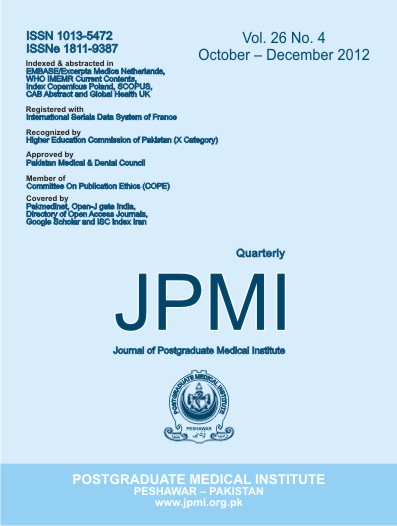CHEMOPROPHYLAXIS IN SURGICAL SITE INFECTION: IS IT REALLY NECESSARY
Main Article Content
Abstract
Objective: To determine the need of using chemoprophylaxis for surgical site infection (SSI) in clean and clean contaminated general surgical procedures and to compare the efficacy of monotherapy using Cefuroxime and combination therapy using Triple Regime.
Methodology: This prospective randomized single blinded study included 534 patients. We included all ASA Grade 1 or 2, immunocompetent patients undergoing clean or clean contaminated surgery. Group A received placebo. Group B received single dose Cefuroxime 750mg iv preoperatively and Group C received triple regime. Any SSI was recorded which occurred up to 30 days post operatively.
Results: The three groups were well matched demographically. (p value < 0.05). Group A (43 patients) was terminated early due to unacceptably high rate of wound infection. Amongst the remaining 491 patients, 247 were randomized to Group B and 244 to Group C. Among the clean cases Group C showed a lower rate of infection (2.6% vs 2.8%; p=0.17). However, Group B had significantly lower infection among the clean contaminated procedures (6.9% vs 7.7%; p=0.03) and overall (4.1% vs 4.9%; p=0.04).
Conclusion: The high rate of infection demonstrated in patients receiving placebo indicates a need for routine chemoprophylaxis for SSI. A single dose of Cefuroxime at induction seems to work at least as well or better than triple regime and is the recommended prophylaxis.
Methodology: This prospective randomized single blinded study included 534 patients. We included all ASA Grade 1 or 2, immunocompetent patients undergoing clean or clean contaminated surgery. Group A received placebo. Group B received single dose Cefuroxime 750mg iv preoperatively and Group C received triple regime. Any SSI was recorded which occurred up to 30 days post operatively.
Results: The three groups were well matched demographically. (p value < 0.05). Group A (43 patients) was terminated early due to unacceptably high rate of wound infection. Amongst the remaining 491 patients, 247 were randomized to Group B and 244 to Group C. Among the clean cases Group C showed a lower rate of infection (2.6% vs 2.8%; p=0.17). However, Group B had significantly lower infection among the clean contaminated procedures (6.9% vs 7.7%; p=0.03) and overall (4.1% vs 4.9%; p=0.04).
Conclusion: The high rate of infection demonstrated in patients receiving placebo indicates a need for routine chemoprophylaxis for SSI. A single dose of Cefuroxime at induction seems to work at least as well or better than triple regime and is the recommended prophylaxis.
Article Details
How to Cite
1.
Faheem F. CHEMOPROPHYLAXIS IN SURGICAL SITE INFECTION: IS IT REALLY NECESSARY. J Postgrad Med Inst [Internet]. 2012 Sep. 24 [cited 2026 Jan. 2];26(4). Available from: https://jpmi.org.pk/index.php/jpmi/article/view/1376
Issue
Section
Original Article
Work published in JPMI is licensed under a
Creative Commons Attribution-NonCommercial 2.0 Generic License.
Authors are permitted and encouraged to post their work online (e.g., in institutional repositories or on their website) prior to and during the submission process, as it can lead to productive exchanges, as well as earlier and greater citation of published work.


